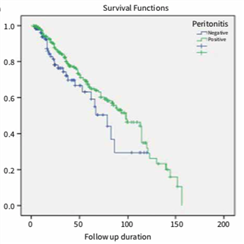Objective: The aim of the present study was to investigate peritonitis episodes and causative agents in patients undergoing peritoneal dialysis (PD), to examine the effects of peritonitis on technical and patient survival, and to determine whether the number of peritonitis episodes and causative agents was a risk factor or not.
Materials and Methods: The medical records of 387 patients who started PD between January 2001 and January 2015 were evaluated retrospectively. Patients without peritonitis (Group 1 (n=123 patients)) and with detected peritonitis (Group 2 (n=243 patients)) were divided into two groups. Group 2 patients were subdivided according to the number of peritonitis (Group 2a 1 episode and Group 2b ≥2 episodes). Sociodemographic data and clinical courses were compared, and the reasons for PD withdrawal were obtained between the groups. Survival analysis was performed, and the effects of peritonitis on mortality were investigated.
Results: A total of 427 peritonitis episodes were detected. The most common organism was Staphylococcus aureus (36%). The leading cause of death was cardiovascular disease in Group 1, whereas it was infection in Group 2a and Group 2b. Technique survival and mortality rates were similar among the groups. Risk factors for patient survival were history of peritonitis more than once and history of catheter exit site/tunnel infection. History of catheter exit site/tunnel infection was the only risk factor for technique survival.
Conclusion: Our study has shown that even though the causes for mortality were different, mortality rates, and technique survival were similar between the two main groups. Infectious complications may affect patient and technical survival.

.png)


.png)

.png)
